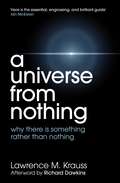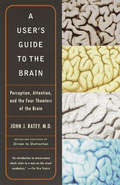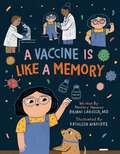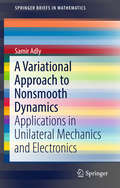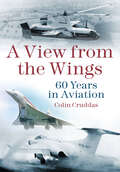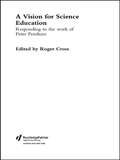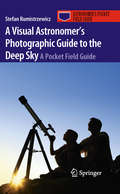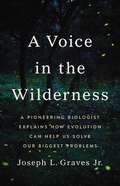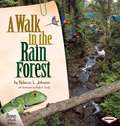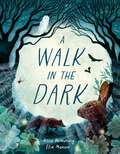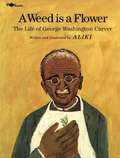- Table View
- List View
A Universe From Nothing
by Lawrence M. KraussInternationally renowned theoretical physicist and bestselling author Lawrence Krauss offers provocative, revelatory answers to the biggest philosophical questions: Where did our universe come from? Why does anything exist? And how is it all going to end? 'Why is there something rather than nothing?' is the question atheists and scientists are always asked, and until now there has not been a satisfying scientific answer. Today, exciting scientific advances provide new insight into this cosmological mystery: not only can something arise from nothing, but something will always arise from nothing. A mind-bending trip back to the beginning of the beginning, A Universe from Nothing authoritatively presents the most recent evidence that explains how our universe evolved - and the implications for how it's going to end. It will provoke, challenge, and delight readers to look at the most basic underpinnings of existence in a whole new way. In the words of Richard Dawkins: this could potentially be the most important scientific book since Darwin's On the Origin of Species.
A Universe from Nothing
by Lawrence M. Krauss“WHERE DID THE UNIVERSE COME FROM? WHAT WAS THERE BEFORE IT? WHAT WILL THE FUTURE BRING? AND FINALLY, WHY IS THERE SOMETHING RATHER THAN NOTHING?” Lawrence Krauss’s provocative answers to these and other timeless questions in a wildly popular lecture now on YouTube have attracted almost a million viewers. The last of these questions in particular has been at the center of religious and philosophical debates about the existence of God, and it’s the supposed counterargument to anyone who questions the need for God. As Krauss argues, scientists have, however, historically focused on other, more pressing issues—such as figuring out how the universe actually functions, which can ultimately help us to improve the quality of our lives. Now, in a cosmological story that rivets as it enlightens, pioneering theoretical physicist Lawrence Krauss explains the groundbreaking new scientific advances that turn the most basic philosophical questions on their heads. One of the few prominent scientists today to have actively crossed the chasm between science and popular culture, Krauss reveals that modern scienceisaddressing the question of why there is something rather than nothing, with surprising and fascinating results. The staggeringly beautiful experimental observations and mind-bending new theories are all described accessibly inA Universe from Nothing,and they suggest that not onlycansomething arise from nothing, something willalwaysarise from nothing. With his characteristic wry humor and wonderfully clear explanations, Krauss takes us back to the beginning of the beginning,presenting the most recent evidence for how our universe evolved—and the implications for how it’s going to end. It will provoke, challenge, and delight readers as it looks at the most basic underpinnings of existence in a whole new way. And this knowledge that our universe will be quite different in the future from today has profound implications and directly affects how we live in the present. As Richard Dawkins has described it: This could potentially be the most important scientific book with implications for supernaturalism since Darwin. A fascinating antidote to outmoded philosophical and religious thinking,A Universe from Nothingis a provocative, game-changing entry into the debate about the existence of God and everything that exists. “Forget Jesus,” Krauss has argued, “the stars died so you could be born. ”
A Universe from Nothing: Why There Is Something Rather than Nothing (Playaway Adult Nonfiction Ser.)
by Lawrence M. Krauss Richard DawkinsBestselling author and acclaimed physicist Lawrence Krauss offers a paradigm-shifting view of how everything that exists came to be in the first place."Where did the universe come from? What was there before it? What will the future bring? And finally, why is there something rather than nothing?"One of the few prominent scientists today to have crossed the chasm between science and popular culture, Krauss describes the staggeringly beautiful experimental observations and mind-bending new theories that demonstrate not only can something arise from nothing, something will always arise from nothing. With a new preface about the significance of the discovery of the Higgs particle, A Universe from Nothing uses Krauss's characteristic wry humor and wonderfully clear explanations to take us back to the beginning of the beginning, presenting the most recent evidence for how our universe evolved--and the implications for how it's going to end. Provocative, challenging, and delightfully readable, this is a game-changing look at the most basic underpinning of existence and a powerful antidote to outmoded philosophical, religious, and scientific thinking.
A User's Guide to the Brain: Perception, Attention, and the Four Theatres of the Brain
by John J. RateyJohn Ratey, bestselling author and clinical professor of psychiatry at Harvard Medical School, here lucidly explains the human brain’s workings, and paves the way for a better understanding of how the brain affects who we are. Ratey provides insight into the basic structure and chemistry of the brain, and demonstrates how its systems shape our perceptions, emotions, and behavior. By giving us a greater understanding of how the brain responds to the guidance of its user, he provides us with knowledge that can enable us to improve our lives. InA User’s Guide to the Brain, Ratey clearly and succinctly surveys what scientists now know about the brain and how we use it. He looks at the brain as a malleable organ capable of improvement and change, like any muscle, and examines the way specific motor functions might be applied to overcome neural disorders ranging from everyday shyness to autism. Drawing on examples from his practice and from everyday life, Ratey illustrates that the most important lesson we can learn about our brains is how to use them to their maximum potential.
A Vaccine Is Like a Memory
by Rajani LaRoccaThis timely book details the importance of vaccines and how they were developed throughout history, as well as how they work to protect your body and keep it healthy.Do you remember every time you've been sick?You may not, but your body does! With many illnesses, you can't get sick more than once because your body remembers and fights it off before you get sick again. But what if your body could recognize germs that you've never had before so you don't get ill? There's where vaccines come in! This book comes complete with extensive back matter all about types of germs and vaccines.
A Variational Approach to Nonsmooth Dynamics
by Samir AdlyThis brief examines mathematical models in nonsmooth mechanics and nonregular electrical circuits, including evolution variational inequalities, complementarity systems, differential inclusions, second-order dynamics, Lur'e systems and Moreau's sweeping process. The field of nonsmooth dynamics is of great interest to mathematicians, mechanicians, automatic controllers and engineers. The present volume acknowledges this transversality and provides a multidisciplinary view as it outlines fundamental results in nonsmooth dynamics and explains how to use them to study various problems in engineering. In particular, the author explores the question of how to redefine the notion of dynamical systems in light of modern variational and nonsmooth analysis. With the aim of bridging between the communities of applied mathematicians, engineers and researchers in control theory and nonlinear systems, this brief outlines both relevant mathematical proofs and models in unilateral mechanics and electronics.
A View from the Wings: 60 Years in British Aviation
by Colin CruddasMany books have been produced which detail the lives and thoughts of famous individuals. A View from the Wings is unique, recalling a wartime boyhood in which aircraft flying constantly overhead played a large part. This experience led to a lifetime career in the aviation industry both in the UK and overseas such as the US and South Africa. Mixed with events of a more personal nature often coated with whimsical humour, the author has evocatively captured the rise and demise of Britain’s aircraft industry in the post-war period. In setting out to be non-technical, A View from the Wings will appeal to those whose memories embrace the sound barrier-breaking years and the leap of faith and technology that saw Concorde defeat the Americans in the race to produce a practical supersonic airliner. All too often political procurement and technical failures have made for dramatic headlines and these too are subjected to much critical comments. Think of the critically acclaimed Empire of the Clouds (Faber and Faber, 2010), but instead of a boyhood observer, the author was an active part of the British aviation industry in its former prime and eventual implosion.
A Vision for Science Education: Responding to Peter Fensham's Work
by Roger CrossOne of the most important and consistent voices in the reform of science education over the last thirty years has been that of Peter Fensham. His vision of a democratic and socially responsible science education for all has inspired change in schools and colleges throughout the world. Often moving against the tide, Fensham travelled the world to promote his radical ideology. He was appointed Australia's first Professor of Science Education, and was later made a Member of the Order of Australia in recognition of his work in this new and emerging field of study.In this unique book, leading science educators from around the world examine and discuss Fensham's key ideas. Each describes how his arguments, proposals and recommendations have affected their own practice, and extend and modify his message in light of current issues and trends in science education. The result is a vision for the future of science teaching internationally.Academics, researchers and practitioners in science education around the world will find this book a fascinating insight into the life and work of one of the foremost pioneers in science education. The book will also make inspiring reading for postgraduate students of science education.
A Vision for the U.S. Forest Service: Goals for Its Next Century (Routledge Revivals)
by Roger A. SedjoOriginally published in 2000, this title is a collection of engaging, nontechnical contributions of scholars, policymakers, and forestry officials providing broad reflections on the agency’s past and future, contemporary perspectives about the use and stewardship of public lands, and insightful analyses about the science involved in the practice of scientific management. The authors offer challenging ideas for evaluating the performance of the U.S. Forest Service, reshaping its mission, enhancing its effectiveness, improving internal morale, and increasing public participation in the agency. It is a valuable resource for policymakers, professional foresters, and any student interested in Environmental Studies.
A Vision of Modern Science: John Tyndall and the Role of the Scientist in Victorian Culture (Palgrave Studies in the History of Science and Technology)
by Ursula DeyoungAn examination of a pivotal moment in the history of science through the career and cultural impact of the historically neglected Victorian physicist John Tyndall,establishing him as an important figure of the period, whose scientific discoveries and philosophy of science in society are still relevant today.
A Visit to a Space Station: Fantasy Science Field Trips (Fantasy Science Field Trips Ser.)
by Claire ThropBooks in the Fantasy Field Trips series take the reader on field trips to the most unlikely of destinations! In this book, strap yourself in as we prepare to blast off to explore a space station far above the Earth's surface. Our 'tour' includes a look at daily life on board, how astronauts exercise, work and even go to the toilet, and how astronauts and their supplies are transported between Earth and the space station.
A Visual Astronomer's Photographic Guide to the Deep Sky: A Pocket Field Guide (Astronomer's Pocket Field Guide)
by Stefan RumistrzewiczThis book is meant for observers who see a deep-sky object - either by star-hopping or by using a Go-To telescope - but do not observe it in detail because they don't know what to look for. It provides photographic images of all the objects discussed... not just images, but images that look exactly like the visual view through the eyepiece of telescopes of various apertures. Visually, deep-sky objects almost always look quite unlike the usual CCD images published in astronomical guides. The human eye doesn't see color at such low light levels, and the contrast of extended objects (such as nebulae and galaxies) is completely different. The author lives in a less-than ideal location for visual observing, with the city of London only about twenty miles to the south. He uses this to advantage, and amateur astronomers will find this book invaluable because it shows them what they will actually see from a typical suburban location, not a rare view under perfect skies.
A Visual Atlas of Skeletal Growth and Development
by Heather M. Garvin Kyra E. StullA Visual Atlas of Skeletal Growth and Development provides professionals, practitioners, and students with a single resource that visually illustrates the skeletal growth and development of individual human bones from birth until skeletal maturity.Each chapter focuses on a specific element and provides visualizations at annual increments along with multiple views. The long bones, elements of the pelvic and shoulder girdles, and the skull are included in this resource. The visualizations are derived from virtual reconstructions of computed tomography scans of actual subadult material carefully selected and chosen to exemplify typical developmental stages at each age. In addition to the visualizations, statistical data on ages of appearance of ossification centers and epiphyseal fusion are provided in tables for quick comparison and reference. Univariate age estimation diagrams, along with a broader discussion and recommendations for subadult age estimation, are also provided. These data and images were derived from data collected from approximately 5,000 individuals via medical images in eight countries that are curated in the Subadult Virtual Anthropology Database.A Visual Atlas of Skeletal Growth and Development will be a vital reference for professionals and students in biological anthropology, human biology, and health sciences, and is a useful resource for individuals interested in learning about the growth and development of the skeleton through images and empirical data.
A Voice in the Wilderness: A Pioneering Biologist Explains How Evolution Can Help Us Solve Our Biggest Problems
by Professor Joseph L Graves Jr.Why understanding evolution—the most reviled branch of science—can help us all, from fighting pandemics to undoing racism Evolutionary science has long been regarded as conservative, a tool for enforcing regressive ideas, particularly about race and gender. But in A Voice in the Wilderness, evolutionary biologist Joseph L. Graves Jr.—once styled as the &“Black Darwin&”—argues that his field is essential to social justice. He shows, for example, why biological races do not exist. He dismantles recent work in &“human biodiversity&” seeking genes to explain the achievements of different ethnic groups. He decimates homophobia, sexism, and classism as well. As a pioneering Black biologist, a leftist, and a Christian, Graves uses his personal story—his journey from a child of Jim Crow to a major researcher and leader of his peers—to rewrite his field. A Voice in the Wilderness is a powerful work of scientific anti-racism and a moving account of a trailblazing life.
A Walk In The Rain Forest
by Rebecca L. JohnsonTake a walk in the rain forest. This hot and humid biome is home to countless trees, animals, plants, and insects. Each and every insect, plant, and animal of the rain forest is dependent on all the others. Explore this exciting world of howling monkeys, calling birds, and endless rain.
A Walk Through The Heavens
by Wil Tirion Milton D. HeifetzA Walk through the Heavens is a guide to the pathways of the sky. It contains unique, simplified maps of the constellations and instructions on how to measure their sizes and the separations between them. Using this information you can find the constellations very easily and take a mind's eye journey from one constellation to its neighbours. The ancient myths and legends surrounding the constellations are retold, enriching our understanding of how historical peoples saw the awe-inspiring spectacle of a sky sprinkled with stars. Magically illustrated by Wil Tirion, this book does not assume that the reader has binoculars, and is ideal to inspire the young astronomer just starting out on a journey across the starlit skies.
A Walk in the Dark
by Alice HemmingA dusk till dawn walk through nature through the eyes of the animals who hunt, scavenge, play, dig and build while most people are tucked up in bed.Beginning just as the human world is slowing down for the evening, A Walk in the Dark takes the reader into the woods and the moonlit countryside. As the sun sets, a family of rabbits hop out of their burrows . . . until they spot a hungry fox returning to the badger's sett . . . and follow the badger through a field where wood mice hide from owls circling overhead . . .With fact boxes on every page and tips on how we can all help nocturnal animals, little ones will discover a whole world that's taking place in the dark.
A Walk in the Tundra (Biomes of North America)
by Rebecca L. JohnsonAn interactive, narrative tone invites readers to walk through America's biomes in this series by award-winning science author Rebecca L. Johnson. Supports the national science education standards Unifying Concepts and Processes: Systems, Order, and Organization; Unifying Concepts and Processes: From and Function; and Life Science as outlined by the National Academics of Science and endorsed by the National Science Teachers Association.
A Walking Life: Reclaiming Our Health and Our Freedom One Step at a Time
by Antonia MalchikFor readers of On Trails: an incisive, utterly engaging exploration of walking: how it is fundamental to our being human, how we've designed it out of our lives, and how it is essential that we reembrace it"I'm going for a walk." How often has this phrase been uttered by someone with a heart full of anger or sorrow? Or as an invitation, a precursor to a declaration of love? Our species and its predecessors have been bipedal walkers for at least six million years; by now, we take this seemingly arbitrary motion for granted. Yet how many of us still really walk in our everyday lives? Driven by a combination of a car-centric culture and an insatiable thirst for productivity and efficiency, we're spending more time sedentary and alone than we ever have before. If bipedal walking is truly what makes our species human, as paleoanthropologists claim, what does it mean that we are designing walking right out of our lives? Antonia Malchik asks essential questions at the center of humanity's evolution and social structures: Who gets to walk, and where? How did we lose the right to walk, and what implications does that have for the strength of our communities, the future of democracy, and the pervasive loneliness of individual lives? The loss of walking as an individual and a community act has the potential to destroy our deepest spiritual connections, our democratic society, our neighborhoods, and our freedom. But we can change the course of our mobility. And we need to. Delving into a wealth of science, history, and anecdote -- from our deepest origins as hominins to our first steps as babies, to universal design and social infrastructure, A Walking Life shows exactly how walking is essential, and how deeply reliant our brains and bodies are on this simple pedestrian act -- and how we can reclaim it.
A Watershed Runs Through You: Essay, Talks, and Reflections on Salmon, Restoration, and Community
by Freeman HouseThis anthology brings together a selection of essays, articles, and lectures that represent the work of environmentalist Freeman House, whose work built the involvement of local citizens in the restoration of watersheds in northern California. "Consequences flow downstream," he points out, "and we're all in their path." While much of House's work focuses on the restoration of wild salmon populations, he shows how all life is connected and interdependent. His restoration efforts in the Mattole Watershed contain blueprints for restoration efforts everywhere.
A Wealth Of Wild Species: Storehouse For Human Welfare
by Norman MyersThis book tells how our welfare is ever more intimately tied up with the welfare of the millions of species that share the One Earth home with us. It presents a synoptic review of the contributions that wild species make, and can make, to our daily lives.
A Weed is a Flower: The Life of George Washington Carver
by AlikiBrief text and pictures present the life of George Washington Carver, born a slave, who became a scientist and devoted his entire life to helping the South improve its agriculture.
A Well-Ordered Thing: Dmitrii Mendeleev and the Shadow of the Periodic Table, Revised Edition
by Professor Michael D. GordinDmitrii Mendeleev (1834–1907) is a name we recognize, but perhaps only as the creator of the periodic table of elements. Generally, little else has been known about him. A Well-Ordered Thing is an authoritative biography of Mendeleev that draws a multifaceted portrait of his life for the first time. As Michael Gordin reveals, Mendeleev was not only a luminary in the history of science, he was also an astonishingly wide-ranging political and cultural figure. From his attack on Spiritualism to his failed voyage to the Arctic and his near-mythical hot-air balloon trip, this is the story of an extraordinary maverick. The ideals that shaped his work outside science also led Mendeleev to order the elements and, eventually, to engineer one of the most fascinating scientific developments of the nineteenth century. A Well-Ordered Thing is a classic work that tells the story of one of the world’s most important minds.
A Whirlwind History of the Universe and Mankind: From the Big Bang to the Higgs Boson
by Thomas SanfordThis book is an essential read for everyone who is curious about how we humans came to exist and interested in understanding the science and social evolution that enabled us to establish that a Big Bang actually happened. The text uniquely explains the transitions between the various evolutionary plateaus: from the universe’s beginning in the Big Bang, to the emergence of Homo sapiens, highlighting the Mediterranean civilizations of Greece and Rome, the European Renaissance, the English industrial revolution, and the early European science discoveries, particularly those in physics, to the American Manhattan Project and the subsequent development of the new field of high-energy particle physics. This entire route, which eventually culminated in the discovery of the mass-giving Higgs boson, is clearly articulated in this monumental but concise work.
A Whole New Me
by Nicole GillMany insects and amphibians change shape—or metamorph—completely. Why do they do it?
